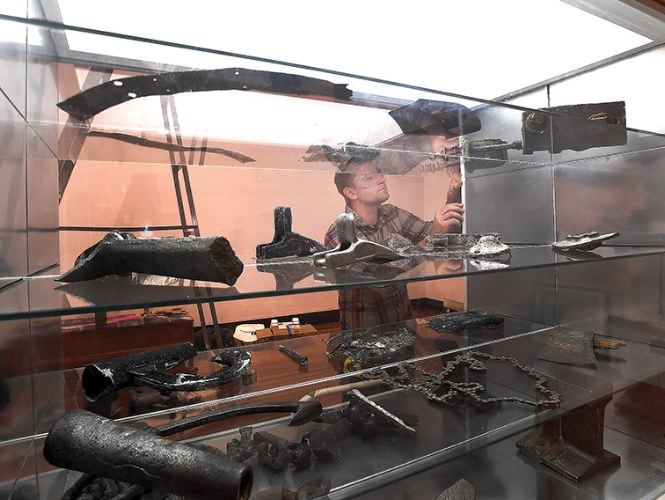The flakes of old industrial activity have been swept by Colin Lyons into a new arrangement. Their previous uses are still hinted at, but they have been altered or replicated or reimagined into Prototypes for the Preservation of Degradation.
Preserving degradation is a time loop, a catch-22, a cycle of things held up for observation as they are falling apart. Lyons has captured this condition in his new and all original art exhibition, and he has added value as well. The degrading pieces of chain and concrete, spikes and steel hooks, have in many cases been polished or artistically enhanced to amplify their voices from the past.
In some cases, Lyons has used the remnants of his own main medium, printmaking, to make recycled figures of industry out of his own industry. He did this by using zinc etching plates to shape other items like miniature buildings, replicas of the buildings that surrounded him in a transitioning neighbourhood of Montreal when he lived there.
"This part of the show is called Boomtown," he said. "I did it back in 2007-09, it's the oldest part of this exhibition."
He observed the large old warehouses and light industrial buildings around the Lachine Canal were often empty, unkempt and in some cases being converted to totally different uses. He took his used print plates and repurposed them for the miniature replicas that he piled up in a faux scrap heap at the centre of the Boomtown chapter of the exhibition.
"Using them in that form made them obsolete but also gave them a second purpose, which is what I was seeing in Montreal," he said.
Boomtown set in motion a decade of similar work. He moved to seven provinces or states in that past 10 years, always exploring the concept of old industry fading away and new uses growing through the cracks in that concrete.
One of the places he lived was Kamloops and there, despite having to bend some railroad rules, managed to find and make a study of Six Mile Mill, an abandoned sawmill north of the downtown only accessible across rail company land.
Part of what he did was take found objects there and treat them with printmaking chemicals "not the way a chemist would use them but more as an alchemist would," but also make replicas so there was a juxtaposition of old steel made to look newer and new creations made to look like those abandoned and rusting old bits of machinery. That chapter is called New Monuments/Old Foundations.
Another chapter looks at the Chicago Harbour Lock that played a role in halting a cholera outbreak when that city's sewage and drinking water met in the same spot on Lake Michigan.
These reflective representations of old and new, cutting edge and obsolescence, fill the entire Canfor North display space at the Two Rivers Gallery. The craft of printmaking is ever-present in spite of all the different components that make up the overall exhibition. Some have been on public display before, some is new, and it has never been assembled by Lyons into a single aggregate show like this one.
"I'm trying to think about printmaking, about obsolescence, about the way we represent industry in history, about all the processes," Lyons said.
"We can represent these time spans without glorifying them, or being sentimental. We can look back, we can assess, we can also add new labour to it and make it something somewhat different. I am imbedding labour into this new history."
Our own new history has to accommodate new thinking in the way industry is set up and the way lives are lived. Like the extreme wildfires of B.C. becoming so routine it must now be considered the "new normal," so to are previous flood plains and storm patterns and other environmental conditions no longer applicable to the previously understood time frames.
"We can't calculate what normal will be, in the new frames of time," Lyons said.
"I'm trying to confront that we are hitting the point of no return. If we don't do something now to fix it, we will need techno-solutions, and that will trigger their own unpredictable changes. Every industrial action has its side effects."
Lyons will be at the Two Rivers Gallery tonight for an artist's talk as part of the unveiling of Prototypes for the Preservation of Degradation. The free public reception gets underway at 7:30 p.m.
All are welcome and refreshments will be available.



